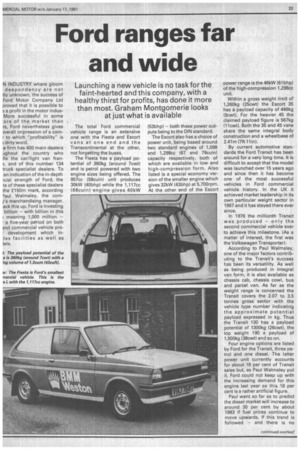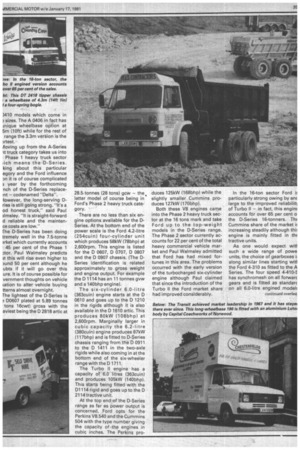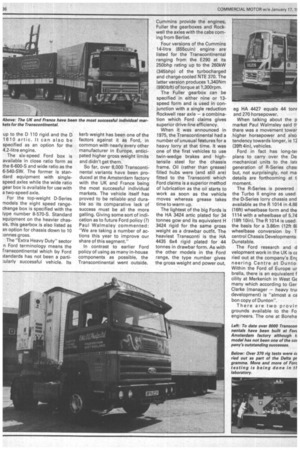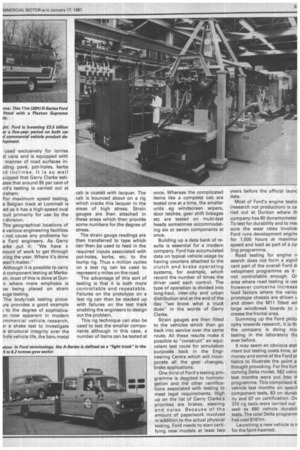Ford ranges far and wide
Page 35

Page 36

Page 37

Page 38

Page 39

If you've noticed an error in this article please click here to report it so we can fix it.
Launching a new vehicle is no task for the faint-hearted and this company, with a healthy thirst for profits, has done it more than most. Graham Montgomerie looks at just what is available
N INDUSTRY where gloom despondency are not tly unknown, the success of Ford Motor Company Ltd proved that it is possible to 3 a profit in the motor indusMore successful in some ors of the market than rs, Ford nevertheless gives werall impression of a cornto which "profitability" is dirty word.
e firm has 400 main dealers ighout the country who lie the car/light van fran, and of this number 134 truck specialist dealers. To an indication of the in-depth icial strength of Ford, the ts of these specialist dealers the £150m mark, according Daul Walmsley, the corn's merchandising merchandising manager. ack this up, Ford is investing billion — with billion in this meaning 1,000 million
a five-year period on both 3 n d commercial vehicle pro: development which ines facilities as well as iels.
The total Ford commercial vehicle range is an extensive one with the Fiesta and Escort vans at one end and the Transcontinental at the other, not forgetting the buses.
The Fiesta has a payload potential of 360kg (around 7cwt) and is petrol powered with two engine sizes being offered. The 957cc (58cuin) unit produces 30kW (40bhp) while the 1,117cc (68cuin) engine gives 40kW (53bhp) — both these power outputs being to the DIN standard.
The Escort also has a choice of power unit, being based around two standard engines of 1,098 and 1,298cc (67 and 79cuin) capacity respectively, both of which are available in low and high-compression form. Also listed is a special economy version of the smaller engine which gives 32kW (43bhp) at 5,700rpm. At the other end of the Escort power range is the 46kW (61bhp) of the high-compression 1,298cc unit.
Within a gross weight limit of 1,260kg (25cwt) the Escort 35 has a payload capacity of 446kg (9cwt). For the heavier 45 the claimed payload figure is 567kg (11cwt). Both the 35 and 45 vans share the same integral body construction and a wheelbase of 2.41m (7ft 11 in).
By current automotive standards the Ford Transit has been around for a very long time. It is difficult to accept that the model was launched over 15 years ago and since then it has become one of the most successful vehicles in Ford commercial vehicle history. In the UK it achieved market leadership in its own particular weight sector in 1967 and it has stayed there ever since.
In 1976 the millionth Transit was produced — only the second commercial vehicle ever to achieve this milestone. (As a matter of interest, the first was the Volkswagen Transporter).
According to Paul Walmsley, one of the major factors contributing to the Transit's success has been its versatility. As well as being produced in integral van form, it is also available as chassis cab, chassis cowl, bus and parcel van. As far as the weight range is concerned the Transit covers the 2.07 to 3.5 tonnes gross sector with the vehicle type number indicating the approximate potential payload expressed in kg. Thus the Transit 130 has a payload potential of 1300kg (26cwt), the top weight 190 a payload of 1,900kg (38cwt) and so on.
Four engine options are listed by Ford for the Transit, three petrol and one diesel. The latter power unit currently accounts for about 18 per cent of Transit sales but, as Paul Walmsley put it, Ford could not keep up with the increasing demand for this engine last year so this 18 per cent is a rather artificial figure.
Paul went so far as to predict the diesel market will increase to around 30 per cent by about 1983 if fuel prices continue to move upwards. If this trend is followed — and there is no reason to suppose that it will not be — then the break-even point of petrol versus diesel comes down steadily.
The diesel engine is a four-cylinder unit with a capacity of 2.36Iitres (144cuin) which produces 46 kW (6 2 bhp) at 3,600rpm. The most powerful engine which can be specified for the Transit is the 75kW (100bhp) V6 petrol engine which has a capacity of 3.01itres (183cuin). According to Ford, this engine is particularly suited to ambulance and fire appliance work and it is available as a Special Vehicle Order (SVO) on the long-wheelbase Transits with the exceptions of the 100 and 17-seat crewbus variants.
The other two petrol engines are both overhead camshaft designs with capacities of 1.6 and 2.0 litres (98 and 122cuin) respectively producing 48 and 57kW (65 and 78bhp). Like the six-cylinder unit, these four-cylinder engines are designed to run on two-star petrol. On the short-wheelbase Transits, the current percentage split between the 1.6 and 2.0-litre engines is around 85/15.
The two wheelbases available for the Transit are 2.29 and 3.04m (7ft 6in) and 10ft) and they are currently being produced in almost equal proportions.
The Ford C3 automatic gearbox can be specified for the twolitre petrol version (with the exception of the long-wheelbase 100) while a Borg-Warner unit is fitted for operators wanting automatic transmission for the V6 engine. This automatic option only accounts for around two per cent of Transit sales and it has been at this figure for a number of years with no sign of an increase.
One transmission variant which is on the increase in terms of operator interest is the Laycock overdrive. This is listed in the SVO category but such has been the take up that Ford is likely to offer it as a regular production option later this year.
As I mentioned earlier, the Ford definition of a "heavy truck" is one with a gvw greater than 3.5 tons. This, however, is over-simplifying the situation somewhat as Ford then goes on to subdivide this heavy sector into four further categories: Light truck (3.5 to 6.2 tonnes) Phase 1 heavy truck (6.3 to 15.9 tons) Phase 2 heavy truck (16 to 28 tons) Extra heavy-duty (everything above 28 tons) The light truck sector is covered for Ford mainly by the ASeries which accounts for 15.7 per cent of Ford sales in the total "heavy truck" grouping. I use the word "mainly" because there is a degree of overlap in weight terms between the top of the A-Series range and the bottom of the D-Series.
As with the Transit, the ASeries is available with a wide range of specification options in
eluding the same 2.4-litre diesel engine. This engine shares many common components with the 3.5-litre (214cuin) engine developed by Ford particularly for the A-Series. It produces 65kW (87bhp) at 3,600 rpm with a maximum torque of 188Nm (138Ibft) at 2,200rpm. The engine range is completed by the same three-litre V6 engine used in the Transit.
The A-Series range also offers a choice of two gearboxes. The Ford built 4-310 gearbox has four speeds while for the operator requiring a five-speed box the ZF S5-24 is available as an option.
Because of the licensing re
quirements, Paul Walmsley E a greater polarisation around 3.5 and 7.5-tonne-weight c gories with operators mor. down to 3.5 or up to 7.5-to systems. It is a small operat vehicle in the main — althoi to disprove this the Post Of has 300 — with "small" in F terminology meaning up to vehicles. To qualify as a "1 owner" as far as Ford is ( cerned, an operator must rut vehicles which can include as well so it is quite possibil qualify as a fleet owner 1, about 15 commercial vehic Currently Ford has about 3, fleet operators on its list.
Most of the A-Series vath are available with a choicE three wheelbases at 3.30, : and 3.96m (10ft 10in, 12ft 13ft). The exceptions are lower weight A 0406, A 0409
)410 models which come in ) sizes. The A 0406 in fact.has inique wheelbase option at 5m (10ft) while for the rest of range the 3.3m version is the )(test.
/loving up from the A-Series Tt truck category takes us into Phase 1 heavy truck sector lich means the D-Series. king about this particular egory and the Ford influence an it is of course complicated 3 year by the forthcoming nch of the D-Series replacent codenamed "Delta".
-Iowever, the long-serving Dries is still going strong. "It's a od honest truck," said Paul ilmsley. "It is straight-forward d reliable and the maintence costs are low."
[he D-Series has been doing tremely well in the 7.5-tonne 3rket which currently accounts
• 45 per cent of the Phase 1 :3tor. Paul Walmsley predicts it this will rise even higher to )und 50 per cent although he ubts if it will go over this ure. It is of course possible for vernment thoughts on vehicle cation to alter vehicle buying tterns almost overnight.
The lightest of the 0-Series is 3 D0607 plated at 5.89 tonnes tons 16cwt) gross with the aviest being the 02818 artic at
28.5,tonnes (28 tons) gcw — the1 latter model of course being in Ford's Phase 2 heavy truck category.
There are no less than six engine options available for the 0Series. At the bottom end of the power scale is the Ford 4.2-litre (254cuin) four-cylinder unit which produces 58kW (78bhp) at 2,600rpm. This engine is listed for the D 0607, D 0707, 0 0807 and the D 0907 chassis. (The DSeries identification is related approximately to gross weight and engine output. For example the ED 1114 has an 11 tonnes gvw and a 1406hp engine).
The six-cylinder 6.0-litre (363cuin) engine starts at the D 0610 and goes up to the D 1210 in the rigids although it is also available in the D 1610 artic. This produces 80kW (108bhp) at 2,600rpm. Marginally larger in cubic capacity the 6.2-litre (380cuin) engine produces 87kW (117bhp) and is fitted to D-Series chassis ranging from the D 0911 to the D 1411 in the two-axle rigids while also coming in at the bottom end of the six-wheeler range with the D 1711.
The Turbo II engine has a capacity of 6.0 litres (363cuin} and produces 105kW (140bhp). This starts being fitted with the D1114 rigid and goes up to the ED 2114 tractive unit.
At the top end of the 0-Series range as far as power output is concerned, Ford opts for the Perkins V8.540 and the Cummins 504 with the type number giving the capacity of the engines in cubic inches. The Perkins pro
dUces 125kW (168bhp) while the slightly smaller Cummins produces 127kW (170bhp).
Both these VS engines came into the Phase 2 heavy truck sector at the 16 tons mark and take Ford up to the top-weight models in the 0-Series range. The Phase 2 sector currently accounts for 22 per cent of the total heavy commercial vehicle market and Paul Walmsley admitted that Ford has had mixed fortunes in this area. The problems occurred with the early version of the turbocharged six-cylinder engine although Paul claimed that since the introduction of the Turbo II the Ford market share had improved considerably. In the 16-ton sector Ford particularly strong owing by ant large to the improved reliabilit) of Turbo II — in fact, this engin( accounts for over 65 per cent o the D-Series 16-tonners. Th( Cummins share of the market i( increasing steadily although &II( engine is mainly fitted in th( tractive units, As one would expect witl such a wide range of powe units, the choice of gearboxes i: along similar lines starting witl the Ford 4-310 as fitted to the A Series. The four speed 4-410-s has synchromesh on all forwarc gears and is fitted as standarc on all 6.0-litre engined model( up to the D 110 rigid and the D 1610 artic. It can also be specified as an option for the 4.2-litre engine.
The six-speed Ford box is available in close ratio form as the 6-600-S and wide ratio as the 6-540-SW. The former is standard equipment with singlespeed axles while the wide ratio gear box is available for use with a two-speed axle.
For the top-weight D-Series -node's the eight speed rangechange box is specified with the type number 8-570-S. Standard equipment on the heavier chassis, this gearbox is also listed as an option for chassis down to 10 :onnes gross.
The "Extra Heavy Duty" sector n Ford terminology means the franscontinental which by Ford standards has not been a parti;ularly successful vehicle, Its kerb weight has been one of the factors against it as Ford, in common with nearly every other manufacturer in Europe, anticipated higher gross weight limits and didn't get them.
So far, over 8,000 Transcontinental variants have been produced at the Amsterdam factory with the UK and France being the most successful individual markets. The vehicle itself has proved to be reliable and durable so its comparative lack of success must be all the more galling. Giving some sort of indication as to future Ford policy (?) Paul Walmsley commented: ''We are taking a number of actions this year to improve our share of this segment."
In contrast to earlier Ford policy of using as many in-house components as possible, the Transcontinental went outside. Cummins provide the engines, Fuller the gearboxes and Rockwell the axles with the cabs coming from Berliet.
Four versions of the Cummins 14-litre (855cuin) engine are listed for the Transcontinental ranging from the E290 at its 250bhp rating up to the 260kW (345bhp) of the turbocharged and charge-cooled NTE 370. The latter version produces 1,340Nm (990Ibft) of torque at 1,300rpm.
The Fuller gearbox can be specified in either nine or 13speed form and is used in conjunction with a single reduction Rockwell rear axle — a combination which Ford claims gives superior drive-line efficiency.
When it was announced in 1975, the Transcontinental had a number of unusual features for a heavy lorry at that time. it was one of the first vehicles to use twin-wedge brakes and hightensile steel for the chassis frame. Oil (rather than grease) filled hubs were (and still are) fitted to the Transconti which Ford claims is a superior method of lubrication as the oil starts to work as soon as the vehicle moves whereas grease takes time to warm up.
The lightest of the big Fords is the HA 3424 artic plated for 34 tonnes gcw and its equivalent H 3424 rigid for the same gross weight as a drawbar outfit, The heaviest Transc.onti is the HA 4435 6x4 rigid plated for 44 tonnes in drawbar form. As with the other models in the Ford range, the type number gives the gross weight and power out, eg HA 4427 equals 44 tonr and 270 horsepower.
When talking about the p market Paul Walmsley said tr there was a movement towar higher horsepower and also tendency towards longer, ie 12 (39ft 4in), vehicles.
Ford in fact has long-ter plans to carry over the De mechanical units to the lat( generation of R-Series chas: but, not surprisingly, not ma details are forthcoming at t moment.
The R-Series is powered the Turbo ll engine as used the D-Series lorry chassis and available as the R 1014 in 4.8E (16ft) wheelbase form and the 1114 with a wheelbase of 5.74 (18ft 10in). The R 1014 is used the basis for a 3.86m (12ft 8i wheelbase conversion by T centrol Chassis Developments Dunstable.
The Ford research and d velopment work in the UK is cz ried out at the company's Enc. neering Centre at Dunto Within the Ford of Europe ur brella, there is an equivalent f cility at Merkenich in West GE many which according to Ger Clarke (manager — heavy trul development) is "almost a ca bon copy of Dunton".
There are two provin grounds available to the Fo engineers. The one at Boreha used exclusively for lorries d vans and is equipped with manner of road surfaces inKling pave, pot-holes, kerbs id inclines. It is so well luipped that Gerry Clarke estiates that around 95 per cent of 'rd's testing is carried out at )reham.
For maximum speed testing, e Belgian track at Lommell is ed as it has a high-speed oval 'cult primarily for use by the r division.
The geographical locations of e various engineering facilities ) not cause any problems for e Ford engineers. As Gerry arke put it: "We have x nount of work to get through iring the year. Where it's done )esn't matter."
Although it is possible to carry it component testing at Merkech, most of this is done at Dun n where more emphasis is )vv being placed on strain luge testing.
The body/cab testing proceJre provides a good example ; to the degree of sophisticapn now apparent in modern )mmercial vehicle research. lr a shake test to investigate
e structural integrity over the hole vehicle life, the bare metal cab is coated with lacquer. The cab is bounced about on a rig which cracks this lacquer in the areas of high stress. Strain gauges are then attached inthese areas which then provide some numbers for the degree of stress.
The strain gauge readings are then transferred to tape which can then be used to feed in the required inputs associated with pot-holes, kerbs, etc, to the bump rig. Thus x million cycles on a test rig can be used to represent y miles on the road.
The advantage of this sort of testing is that it is both more controllable and repeatable. Failures on the prototype on a test rig can then be stacked up with failures on the test track enabling the engineers to design out the problem.
This rig technique can also be used to test the smaller components although in this case, a number of items can be tested at once. Whereas the complicated items like a complete cab are tested one at a time, the smaller units eg windscreen wipers, door latches, gear shift linkages etc are tested on multi-test heads sometimes accommodating six or seven components at once.
Building up a data bank of results is essential for a modern company. Ford has accumulated data on typical vehicle usage by having counters attached to the clutch and brake operating systems, for example, which record the number of times the driver used each control. The type of operation is divided into long-haul, inter-city and urban distribution and at the end of the day "we know what a truck does" in the words of Gerry Clarke.
Strain gauges are then fitted to the vehicles which then go back into service over the same route. All these results make it possible to "construct" an equivalent test route for simulation purposes back in the Engineering Centre which will incorporate all the gear changes, brake applications.
One third of Ford's testing programme is devoted to homologation and the other ramifications associated with testing to meet legal requirements. High up on the list of Gerry Clarke's priorities are brakes, steering and noise. Because of the amount of paperwork involved in addition to the actual physical testing, Ford needs to start certifying new models at least two years before the official launc date.
Most of Ford's engine testin (research not production) is ca ried out at Dunton where th company has 80 dynamometer: To test for durability and to me sure the wear rates involve( Ford runs development engine for 1,500 hours at maximur speed and load as part of a cyl ling programme.
Road testing for engine n search does not form a signif cant part of the overall Ford di velopment programme as it not controllable enough. Or area where road testing is USE however concerns increase load factors where the varioL prototype chassis are driven u and down the M11 fitted wil large windbreak boards to ii crease the frontal area.
Summing up the Ford philo ophy towards research, it is th the company is doing mot testing in the laboratory thz ever before.
It may seem an obvious stat ment but testing costs time, ar money and some of the Ford st tistics to illustrate the point a thought provoking. For the fort coming Delta model, 582 vehic test months were put into tf programme. This comprised 4:. vehicle test months on specif component tests, 83 on durab ity and 67 on certification. Ov 370 rig tests were carried out well as 680 vehicle durabili tests. The total Delta program n has cost $161m.
Launching a new vehicle is n for the faint-hearted.












































































































